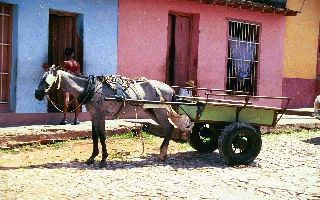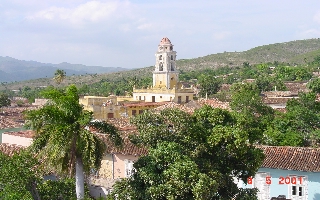Harmonica



N 19 54.8 W 77 11.2
Hello from Marea del Portillo on the south coast of Cuba, backed by the hills & mountains of the Sierra Maestra. We took shelter here at 8.30am after a long wet night of 25 knot easterlies accompanied by torrential thunderstorms. Now clear & sunny; when the winds let up, we shall continue to Santiago de Cuba, and obtain our exit zarpe for Turks & Caicos. There Janet will leave for 3 weeks in Calgary, and Ron Webster will join Dave to sail to Bermuda.
We will have spent over 3 weeks in Cuba. Friends Doug & Fran James, and our son Neil joined us in Trinidad to sail across the shallow, island-strewn Golfo de Anna Maria and Golfo Guacanayabo. The barrier reefs on the outside have few good anchorages and we took an inside passage which was pretty, but lacked the clear water and coral which might have been on the outside. For 200 miles by 40 miles there is flat water 10 to 20 metres deep spattered with mangrove-covered islands with some sandy beaches, so low that they only loom out of the mirage a few miles away. The only inhabitants seem to be lizards, iguanas and a variety of birds.
At our first stop, the 3 man crew of a local fishing boat came alongside to see us, and we were presented with 7 of the biggest lobsters I remember seeing. 2 nights later we were between documented anchorages so we tucked behind a strip of sand 100 metres long, which could not even support a tree. The beach was made up of coral pieces and a variety of shells much to the delight of Janet. 2 nights later, we were again visited by fishermen who came aboard and were interested to see our engine & electronic equipment; we gave them drinks & they left us with some lovely fresh fish. Their own boat was well-organized, but tiny and rudely equipped (not even a compass and they seemed in no hurry to start the 4 hour trip home night upon them & thunder in the distance. We compared their spartan equipment & 5 days on, 5 days off regime with the shrimpers in the Sea of Cortez who worked a month for 3 days home with their families.
Physically, the country seems quiet, spacious, & varied. The mountains behind Trinidad are remote, & steep enough that our rented Dewood needed 1st gear to get us up the main road. We saw a few Europeans taking cycling holidays here. The centre of the Island was flat and neatly planted with a range of crops especially sugar cane & citrus trees. Pairs of oxen were being used to till the soil. The sparsity of vehicles added to the feeling of uncrowdedness, and also gives rise to the highly organised system of hitch-hiking. At many intersections there is an official with a clipboard ensuring that hitchers are given rides in the right order. We gave rides to 12 individuals in our 300K drive from Trinidad to Varadero to meet Neil, Doug & Fran, and seemed to be appreciated for this.
We have been in 3 small cities and each has shown the same mix of friendly faces, relaxed life styles, and inattention to repair. Buildings are crumbling, but houses inside are complete and simple but comfortable. People here have lived a generation without the death squads and guerilla armies of Central & South America. Health & education are some of the best in the region, racial integration seems successful, but (except for the orderly fruit & sugar farms in the interior) we saw no attention to repair of buildings & infrastructure. Food supplies are limited. Local people use ration books to obtain basic supplies. We were able to find vegetables and fruit in local markets. Very few private cars are seen on the roads but trucks, buses and tractors are the main means of transport. The cities had small horse and buggies running along the malecon giving rides to the town centre.
The quiet trusting atmosphere was spoilt for us in Manzanillo. We cannot help looking like millionaires arriving in a big white sailing boat, and here at the Restaurante Del Golfo, where we left our dinghy on the beach, we were asked for an exorbitant "tip" for looking after it. Returning late after a heavy rain storm and an excellent supper in a private house, we were met by a bevy of excited people animatedly telling us that our anchor had dragged in the rain, and they had saved our boat from drifting onto the Malecon. Some of these were uniformed officers and they asked me to accompany them while the others returned by dinghy to Harmonica. I was taken in the back seat of an old car (without inside door handles) to the Port Captain's Office where the story was repeated and I was asked to return at 9.00 the next morning. The story did not fit: our anchor had been properly set in extremely sticky mud, there were footprints but no signs of mud on the decks, we record our location to .001 minutes on the GPS and to within a few metres our anchor was still in the same place, next morning I checked the bottom and found no signs of grounding in mud but the dinghy tool kit was missing and the sheer pin broken. The atmosphere on the beach was uncomfortable and we asked to check out immediately. To our relief the day-time officials, as discrete and tactful as ever, gave us our papers to sail at noon towards Santiago. We left Manzanillo hidden in teeming rain and slept at anchor on the other side of the first cay.
This was not typical of what we have experienced, and was started by my inept handling of the request for an inordinate tip. It was a pleasure to return to the other Cuba this morning by sharing bacon & eggs in the cockpit with the Guarda from Marea when he arrived in his rowing boat to check us in here as I was about to serve breakfast. The neighbouring french yacht brought their dinghy over to say hello and offer the Guarda a tow back to his dock. The cruisers are not allowed to go ashore here so we must admire the scenery of beaches backed by palm trees, green hills with grazing animals and a backdrop of green mountains from the boat.
Best wishes
Dave Jan & Harmonica


